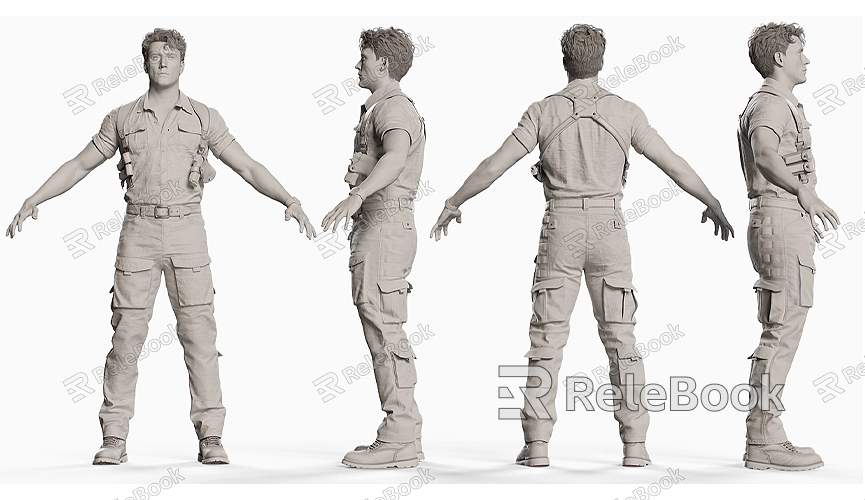How to Create Human Model in SketchUp
Creating 3D models is increasingly common in architecture, interior design, and animation. For creating human models, SketchUp has become a preferred tool for many designers due to its ease of use and flexibility. This article will detail how to create a human model in SketchUp, including the necessary tools, steps, and practical tips. Hopefully, this will help you better realize your design concepts in your projects.
Overview of SketchUp
Before we begin, let's take a look at SketchUp. SketchUp is a powerful 3D modeling software widely used in architecture, interior design, and landscape design. Its user-friendly interface and simple operation make it perfect for beginners. Additionally, SketchUp offers a rich array of plugins and extensions to meet different user needs.

Preparation
Before creating a human model, ensure you have SketchUp installed and are familiar with some basic operations. Here are some preparatory steps:
- Install SketchUp: Visit the official SketchUp website to download and install the latest version of the software.
- Familiarize with Basic Tools: Get to know the basic drawing tools in SketchUp, such as the line tool, rectangle tool, and push/pull tool.
Steps to Create a Human Model
Creating a human model can be complex, but following these steps can simplify the process.
Choose Suitable Reference Images
Selecting appropriate reference images before modeling is crucial. Opt for side and front view images to help you better understand human proportions and structure.
1. Prepare Reference Images: Search online for high-quality human images, ensuring clear angles.
2. Import Reference Images: In SketchUp, go to the "File" menu and select "Import" to bring in your reference images.
Draw Basic Shapes
Using SketchUp's basic drawing tools, create the foundational shapes of the human model, mainly to outline the body's basic silhouette.
1. Draw the Head: Use the circle tool to create the head's basic outline.
2. Draw the Torso: Use the push/pull tool to extend the shape of the torso.
3. Add Limbs: Create arms and legs, potentially using the cylinder tool for modeling.
Adjust Proportions and Details
After establishing the basic shapes, adjust the model to align with realistic human proportions.
1. Adjust Proportions: Use the scale tool to modify each part of the model, ensuring overall proportionate harmony.
2. Add Details: Incorporate finer details, such as facial features, fingers, and toes, using drawing and push/pull tools.
Apply Materials and Textures

To enhance realism, add materials and textures to the model.
1. Select Materials: In the right-side materials panel, choose appropriate skin tones or textures.
2. Apply Textures: Use the materials tool to apply textures to different parts of the model for added realism.
If you need high-quality 3D textures and HDRI for creating models and virtual scenes, you can download them for free from [Relebook](https://textures.relebook.com/). For exquisite 3D models, visit [Relebook](https://3dmodels.relebook.com/) for a variety of high-quality resources.
Final Adjustments and Optimization
Once all details are complete, make final adjustments and optimizations to the model.
1. View Overall Effect: Examine the model from different angles to ensure no details are overlooked.
2. Optimize the Model: Use the "Soften Edges" feature to eliminate sharp edges, making the model appear more natural.
Exporting and Applying the Model
After creating the human model, you can export it in various formats for use in other software.
Export the Model
1. Select Export Options: Click the "File" menu and choose "Export."
2. Choose File Format: Select from various file formats, such as OBJ or FBX, based on your needs.
Application Scenarios
The created human model can be utilized in various scenarios, including architectural visualization, interior design, and animation production. By importing the model into other software, you can perform animation, rendering, and other post-processing tasks to enhance the final output.
Frequently Asked Questions
You may encounter some common issues while creating human models. Here are answers to a few typical questions to assist you in modeling.
How to Maintain Model Proportions?
Using reference images is an excellent method for keeping proportions in check, ensuring all parts are harmonious.
How to Handle Details?
When adding details, employ the push/pull and drawing tools for precise work to ensure model authenticity.
How to Improve Modeling Efficiency?
Mastering SketchUp's shortcuts and utilizing existing model libraries and plugins can significantly boost your modeling efficiency.
By following these steps, you should now have a solid understanding of how to create a human model in SketchUp. Creating 3D models requires patience and attention to detail, but with the right techniques, you can produce impressive work. I hope this article helps you feel more confident in using SketchUp. Best of luck on your 3D modeling journey!

